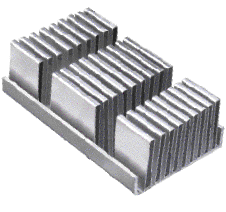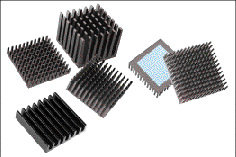Thermal management evolves to keep pace with changing technology
Recent electronics advances dictate custom cooling solutions
BY CHRIS CHAPMAN
Aavid Thermalloy
Concord, NH
http://www.aavid.comToday's cooling trends are defined more by the changes in electronic products than by advances in thermal technologies. The trend in cooling solutions is evolutionary rather than revolutionary–heat sink selection, interface material selection, and fan placement have become more critical, but their basic place in thermal design has not changed. While finer line widths and copper interconnects to the die are improving chip speed without significantly increasing heat dissipation, other trends are increasing cooling requirements. For example, what used to be called “overclocking”–a tendency by end-users to run chips at speeds higher than specified–is becoming a means for chipmakers to introduce faster chips more quickly than they could through technological improvements. To increase the chip speed without changing the technology or compromising reliability, these manufacturers have lowered the maximum operating temperature, accelerating the need for thermal management. The need for additional cooling has spawned a number of proven thermal solutions, in turn giving the thermal designer options applicable to many products. Heat sinks, for instance, are no longer rare inclusions, but are necessary and accepted for many graphics and function-intensive chips. For instance, today's Pentium III motherboard may require as many as six heat sinks. Laptops and desktops Laptops and desktops continue along the same path they have for the last decade: faster processors and smaller packages make it harder to dissipate heat. Thermal design has become an integral part of the design cycle for these products. Desktop designers rely on high-powered fans to move 10 to 75 W of power from the chips to the ambient environment in a relatively roomy box. Notebook designers depend on advanced cooling technologies like heat pipes that move 10 to 20 W from the power-intensive chips to cutting-edge heat sinks. For instance, a folded-fin sink (see Fig. 1 ) maximizes cooling and minimizes weight. When using this type of heat sink, it is important that system-level thermal design be used to ensure that air is ducted through the heat sink in order to achieve its low 0.7 °C/W performance.

Fig. 1. This folded- fin heat sink minimizes the pressure drop across the heat sink, suiting it for applications where space is tight.
Design cycles for electronic products have shrunk to the point where the basic design revolves around a range of device specifications rather than around a specific generation. This is good news for thermal management. Once a design requires cooling, the physical area required to accommodate heat sinks and other cooling solutions is incorporated into the layout. Most designs now designate a 1 to 2-in. area for heat sinks and other cooling solutions. Servers The explosive use of the Internet is fueling the largest growth area in electronics. Servers dedicated to specific functions have become commonplace. Storage servers, gaming servers, network servers, and secure servers for banking and e-commerce all require cooling, but their function dictates how the cooling is specialized. Storage servers, for example, consist of large banks of disk drives. Placing a storage server in an air-conditioned environment and equipping it with multiple fans to move the air will ensure adequate cooling for this type of server. When spot cooling is required, a low-profile aluminum heat sink will perform well with sufficient airflow. Internet gaming servers, on the other hand, are driven by the need for speed. Gaming servers have the most advanced 3-D graphics and multiple processors to increase response time, and include the fastest modems available. Since enclosure size is not a huge selling factor in this type of server, the cards are spread out, increasing heat dissipation. Fan heat sinks typically cool the 3-D cards, and small crosscut BGA heat sinks cool the modem chips (see Fig. 2).

Fig. 2. One of the crosscut BGA heat sinks shown here would be ideal for cooling high-speed modem chips.
Network servers also require speed. To allow for the faster speed enabled by lower temperatures, copper heat sinks often cool the microprocessors and other hot devices in network servers. In this case, the cost vs. speed tradeoff favors the more expensive heat sink material. Due to the increasing requirements of speed and bandwidth, liquid cooling schemes are being considered to remove high heat flux and power levels, without sacrificing product size. With secure servers, speed is less of an issue. The coding and decoding of data as it is transferred builds some delay into each transaction, minimizing the benefits that might be gained by a faster system. These servers include extra boards for redundancy. In addition, specialized boards provide encryption and security. Unlike for traditional motherboards, there are no standards for encryption boards, so the cooling solution is often customized for the board. Like the other servers, secure servers use conventional cooling solutions like heat sinks and cooling fans, but configured specifically as needed by the boards and application. In server applications, multiple processors and scalable and parallel systems combine to make up a single server. Power levels for servers are rarely under 200 W and may go as high as 1 kW on some of the larger servers. Since each application is unique, heat sink optimization is directly related to the amount of system-level thermal engineering that is performed. Communications devices The use of portable communications devices like point-of-sale terminals and cell phones is increasing at an incredible pace. In addition to having space limitations that are even more severe than notebooks, these devices must withstand environmental extremes far worse than most other electronics, and have noise and operating temperature limitations based on their proximity to people. The need to conserve battery power creates a further challenge to the designer. The typical power level requiring cooling in portable communications devices is between 5 and 15 W per chip–the same as notebooks. As with encryption boards, there are few standards in communications board design, so each thermal solution is unique. To date, copper plates in the boards that make up cell phones have proven sufficient to cool these relatively low-power devices. But as the functions of cell phones and palm-top devices merge, the cooling solutions, like those for point-of-sale terminals, will look more like the solutions for today's notebooks.
Advertisement





